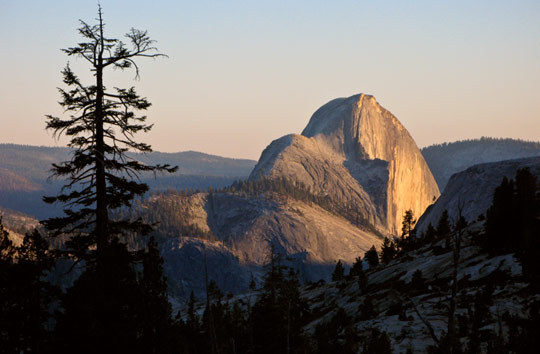
Half Dome as viewed from Tuolumne, Yosemite National Park, California. A management plan for the Merced River may affect climbing and camping at the granite mecca. [Photo] Michael Kennedy
An upcoming management plan for the Merced Wild and Scenic River could have profound impact on Yosemite National Park, including the potential to restrict camping and climbing access.
Alpinist.com first reported on the Merced River Plan in the July 19, 2008 NewsWire. Since then, three rounds of litigation have transformed the nature of the future plan. Courts have mandated that the plan must include a “user capacity program” imposing use limits within the Merced corridor (a quarter-mile on each side of the river) and protect the area while still permitting recreation. The result could take many forms. But no matter the outcome, the result is likely to impact climbers.
Major climbing areas like The Rostrum, Cookie Cliff and Middle Cathedral Rock are located within the Merced corridor itself. Even more significant climbing areas–El Capitan, Half Dome, Sentinel Rock and all the Cathedrals–are accessed via the corridor. Low-impact camping areas, like Camp 4, also could be affected depending on how the park designs the quota system.
Though the plan will not be finalized until 2012, the initial public scoping period ends this Thursday, February 4. The scoping period gives the public a preliminary voice that will influence the direction of the draft plan.
“This is a particularly important time for climbers to comment,” said Jason Keith, Policy Director at The Access Fund. “Really important decisions are made during the scoping phase since public comments give land managers an understanding of who uses the park and what their priorities are.”
If a significant number of climbers provide detailed comments during the public scoping period, Keith said, land managers will be more likely to understand climbing dynamics in the Valley and potentially lend support for climbing to be considered a recreational activity of outstanding remarkable value (ORV), an important designation that could lead to protection of climbing in the corridor.
“The bottom line is that we’re advocating to preserve existing opportunities, not create new amenities,” Keith said. “We want to illustrate that access to camping and climbing is an important part of Yosemite. And at the same time, as climbers, adjust our activity in ways that will be healthy for the corridor in the long run.”
The Access Fund is asking all climbers to send letters to the Park by February 4 that support the preservation of climbing access in Yosemite Valley. The organization has established an easy letter-writing form letter for this project through their online Action Center. More information can be found on the Park’s website: nps.gov.
“This plan is going to be around for a while,” Keith added. “There will be lots of public meetings and workshops that people can be a part of. The Access Fund will make sure to get the word out about all the various steps in the process. But now–before the scoping period ends–is a good time to get after it.”